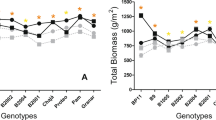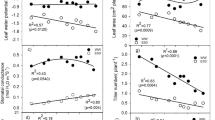Abstract
Drought frequently constrains production of wheat (Triticum aestivum L.), but development of tolerant cultivars is hampered by low heritability for drought tolerance and a lack of effective selection strategies. Our objective was to identify an optimum selection regime for wheat in drought-prone environments. Six-hundred entries derived from 10 crosses were developed by selection under continuous high moisture, alternating high with low moisture, alternating low with high moisture, and continuous low moisture conditions for five generations. The selections were evaluated in two low-yield, a medium-yield, and a high-yield environment in the Yaqui Valley, Sonora, Mexico. The mean performance of entries derived from a particular selection regime was dependant on the stress level of the evaluation environment. Lines developed and selected under continuous high moisture and continuous low-moisture regimes produced the highest mean yields in the low moisture evaluation environment. There was no relationship between continuous selection under either high yielding conditions or low yielding conditions and the mean performance of the resultant lines in their respective high and low yielding evaluation environments. The mean yield of lines selected using the alternating high/low moisture regime as well as the five highest yielding lines were superior in the HY environment, and had similar performance with other regimes under the low yielding evaluation environment. Our results indicate that alternating selection between high and low yielding environments is the most effective way to develop wheat germplasm adapted to environments where intermittent drought occurs.
Similar content being viewed by others
References
Blum, A., 1996. Constitutive traits affecting plant performance under stress. In: G.O. Edmeades, M. Bänzinger, H.R. Mickelson & C.B. Peñ a-Valdivia (Eds.), Developing Drought-and Low Nitrogen-Tolerant Maize, pp. 131-135. CIMMYT, Mexico, D.F.
Brandshaw, A.D., 1965. Evolutionary significance of phenotypic plasticity in plants. Adv Genet 13: 115-155.
Braun, H., W.H. Pfeiffer & W.G. Pollmer, 1992. Environments for selecting widely adapted spring wheat. Crop Sci 32: 1420-1427.
Boubaker, M., 1997. High vs. low stress yield test environments for identifying drought tolerant durum wheat cultivars. Tropicultura 15: 18-21.
Bruckner, P.L. & R.C. Frohberg, 1987a. Stress tolerance and adaptation in spring wheat. Crop Sci 27: 31-36.
Bruckner, P.L. & R.C. Frohberg, 1987b. Rate and duration of grain fill in spring wheat. Crop Sci 27: 451-455.
Byrne, P.F., J. Bolanos, G.O. Edmeades & D.L. Eaton, 1995. Gains from selection under drought versus multilocation testing in related tropical maize populations. Crop Sci 35: 63-69.
Calhoun, D.S., G. Gebeyehu, A. Miranda, S. Rajaram & M. Van Ginkel, 1994. Choosing evaluation environments to increase wheat grain yield under drought conditions. Crop Sci 34: 673-678.
Ceccarelli, S., 1989. Wide adaptation: How wide? Euphytica 40: 197-205.
Ceccarelli, S., S. Grando & A. Impiglia, 1998. Choice of selection strategy in breeding barley for stress environments. Euphytica 103: 307-318.
Cooper, M., R.E. Stucker, I.H. DeLacy & B.D. Harch, 1997. Wheat breeding nurseries, target environments, and indirect selection for grain yield. Crop Sci 37: 1168-1176.
Cox, T.S., R.G. Sears, R.K. Bequette & T.J. Martin, 1995. Germplasm enhancement in winter wheat × Triticum tauchii backcross populations. Crop Sci 35: 913-919.
Donmez, E., R.G. Sears, J.P. Shroyer & G.M. Paulsen, 2001. Genetic gain in yield attributes of winter wheat in the Great Plains. Crop Sci 41: 1412-1419.
Duvick, D.N., 1992. Genetic contributions to advances in yield of US maize. Maydica 37: 69-79.
Edhaie, B., J.G. Waines & A.E. Hall, 1988. Differential responses of landrace and improved spring wheat genotypes to stress environments. Crop Sci 28: 838-842.
Falconer, D.S., 1952. The problem of environment and selection. Am Nat 86: 293-298.
Finlay, K.W., 1968. The significance of adaptation in wheat breeding. In: K.W. Finlay & K.W. Shephard (Eds.), Proc 3rd IntWheat Genet Symp, pp. 403-409. Aust Acad Sci, Canberra.
Fischer, R.A. & R. Maurer, 1978. Drought resistance in spring wheat cultivars. I. Grain yield responses. Aust J Agric Res 29: 897-912.
Hamblin, J., H.M. Fisher & H.I. Ridings, 1980. The choice of locality for plant breeding when selecting for high yield and general adaptation. Euphytica 29: 161-168.
Heine, H. & W.E. Weber, 1982. The significance of statistical parameters for the phenotypic stability in official variety trials of winter wheat and maize. Z Pflanzenzücht 89: 89-99.
Innes, P. & S.A. Quarrie, 1987. Water relations. In: F.G.H. Lupton (Ed.), Wheat Breeding, Its Scientific Basis, pp. 313-337. Chapman Hall, London.
Keim, D.L. & W.E. Kronstad, 1979. Drought resistance and dryland adaptation in winter wheat. Crop Sci 19: 574-576.
Ketata, H., 1987. Actual and potential yields of cereal crops in moisture-limited environments. In: J.P. Shrivastava, E. Porceddu, E. Acevedo & S. Varma (Eds.), Drought Tolerance in Winter Cereals, pp. 55-61. John Wiley and Sons, NY.
Kohli, M.M. & M.A. McMahon, 1988. A perspective of research needs for non-irrigated tropical conditions. In: A.R. Klatt (Ed.), Wheat Production Constraints in Tropical Environments, pp 330-347. CIMMYT, Mexico, D.F.
Laing, D.R. & R.A. Fischer, 1979. Adaptation of semi-dwarf wheat cultivars to rainfed conditions. Euphytica 26: 129-139.
Metzger, D.D., S.J. Czaplewski & D.C. Rasmousson, 1984. Grain filling duration and yield in spring barley. Crop Sci 24: 1101-1105.
McWilliam, J.R., 1989. The dimensions of drought. In: F.W.G. Baker (Ed.), Drought Resistance in Cereals, pp. 1-11. CAB International, Wallingford, Oxon, UK.
Passioura, J.B., 1986. Resistance to drought and salinity: Avenues for improvement. Aust J Plant Physiol 13: 191-201.
Pfeiffer, W.H., K.D. Sayre, S. Rajaram & T.S. Payne, 1989. Empirical approaches to breeding for drought stress. In: Agronomy Abstracts, pp. 95. ASA, Madison, WI.
Rajaram, S., H.J. Braun & M. Van Ginkel, 1996. CIMMYT's approach to breed for drought tolerance. Euphytica 92: 147-153.
Richards, R.A., 1996. Defining selection criteria to improve yield under drought. Plant Growth Regulation 20: 157-166.
Roy, N.N. & B.R. Murty, 1970. A selection procedure in wheat for stress environments. Euphytica 19: 509-521.
SAS Institute, 1990. SAS Users Guide. Statistics (Version 6.0). SAS Inst. Cary, NC.
Schimdt, J.W., 1983. Drought resistance and wheat breeding. Agric Water Manag 7: 181-194.
Simmonds, N.W., 1991. Selection for local adaptation in plant breeding programme. Theor Appl Genet 82: 363-367.
Slafer, G.A. & J.L. Araus, 1998. Improving wheat responses to abiotic stresses. In: A.E. Slinkard (Ed.), Proc 9th Int Wheat Genet Symp. University of Saskatchewan, pp. 201-213. Saskatoon, Saskatchewan.
Smith, M.E., W.R. Coffman & T.C. Baker, 1990. Environmental effects on selection under high and low-input conditions, pp. 261-272. In: M.S. Kang (Ed.), Genotype-by-Environment Interaction and Plant Breeding. Louisiana State University, Baton Rouge, LA.
St. Pierre, C.A., H.R. Klinch & F.M. Gauthier, 1967. Early generation selection under different environments as it influences adaptation of barley. Can J Plant Sci 47: 507-517.
Trethowan, R.M., J. Crossa, M. van Ginkel & S. Rajaram, 2001. Relationships among bread wheat international yield testing locations in dry areas. Crop Sci 41: 1461-1469.
Trethowan, R.M., M. van Ginkel, K. Ammar, J. Crossa, B. Cukadar, S. Rajaram & E. Hernandez, 2003. Associations among twenty years of bread wheat yield evaluation environments. Crop Sci 43: 1698-1711.
van Ginkel, M., D.S. Calhoun, G. Gebeyehu, A. Miranda, C. Tianyu, R.P. Lara, R.M. Trethowan, K. Sayre, J. Crossa & S. Rajaram, 1998. Plant traits related to yield of wheat in early, late or continuous drought conditions. Euphytica 100: 109-121.
Author information
Authors and Affiliations
Rights and permissions
About this article
Cite this article
Kirigwi, F., van Ginkel, M., Trethowan, R. et al. Evaluation of selection strategies for wheat adaptation across water regimes. Euphytica 135, 361–371 (2004). https://doi.org/10.1023/B:EUPH.0000013375.66104.04
Issue Date:
DOI: https://doi.org/10.1023/B:EUPH.0000013375.66104.04




